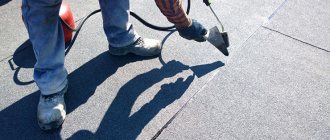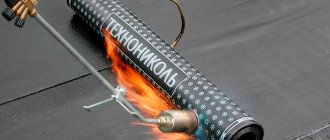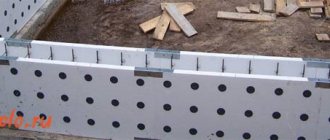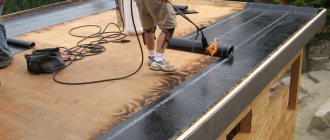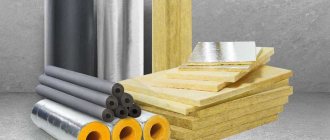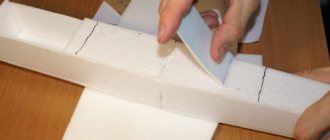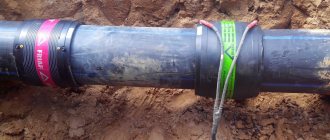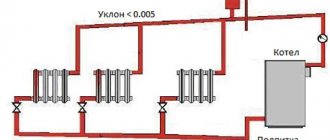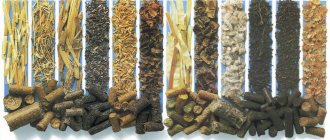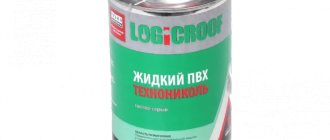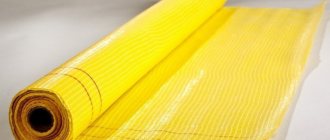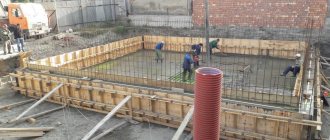Installation of adhesive waterproofing of the foundation - manufacturing instructions
To protect the foundation of a building from the destructive influence of groundwater during construction, certain measures are used, thanks to which the structure will be completely waterproofed. The gluing method of insulation has become extremely popular, in which roll-type materials made of bitumen are attached to the surface by gluing.
Tapered roll waterproofing of the foundation can be carried out by applying melted bitumen to the base under the influence of high temperature. This type of waterproofing will be characterized by ease of use, excellent water and vapor resistance, and durability.
In certain cases, before roll waterproofing, a coating application of a bituminous composition is also used, which will help improve the adhesion of the material and the surface.
Types of roll waterproofing
There are three main types:
- Using roll materials for waterproofing, such as roofing felt, glassine and glass insulation. They will be glued in a couple of layers to the surface of the base using both mastic and a special adhesive layer.
- Fastening the material using the hot method (floating method). This is all done by heating the working part of the material with a gas burner. When the polymer or bitumen layer melts, excellent bonding to the concrete surface will occur.
- With the use of waterproofing film materials - diffuse type membranes, which have a high vapor transmission capacity, which will contribute to excellent protection of the foundation from water and co-control of its level, as well as the removal of steam from inside the building.
Next, let's talk about how to choose material.
Types of waterproofing
This barrier - a waterproofing lining that protects the foundation and other underground structures from moisture, exists in several varieties:
- Coating waterproofing, used mainly in the construction of a building on damp soils, where groundwater lies quite high, and protects the foundation from capillary moisture;
Coating waterproofing
- Impregnated insulation is the impregnation of porous materials such as concrete, limestone or tuff blocks and slabs, pipes and asbestos cement sheets, etc.;
Impregnation waterproofing
- Penetrating waterproofing, which includes compositions that provide volumetric waterproofing of a porous, water-permeable material. The action of such materials (for example, Penebar waterproofing gasket) is based on the penetration of a working substance solution into the porous structure of the surface of the insulated material and its fixation there;
Penetrating waterproofing
- Mounted waterproofing, which is a special design in the form of protective screens made of bentonite mats.
This type of waterproofing is characterized by complexity and high cost; Mounted waterproofing
- Finally, the most common type of waterproofing, characterized by an optimal balance between labor intensity, price and quality, is adhesive self-adhesive waterproofing, which will be discussed in more detail below.
Pasting waterproofing
Selecting insulation for gluing according to operating conditions
Before choosing the type of adhesive-type insulation, it is important to determine the main conditions under which the foundation will be, and what level of humidity and type the soil will be. Rolled building materials can be used for both vertical and horizontal insulation, it all depends on the main function that the material must perform, the choice of coating. The bases for roll-type waterproofing may differ from each other, as well as the binding components. Types of coating may differ in varying degrees of resistance and strength, resistance to chemical components, underground release of radioactive components and underground water pressure.
When laying horizontal insulation of monolithic reinforced concrete slabs with reinforced reinforcement - a slab foundation, as a rule, building materials with an increased degree of base strength (fiberglass or polymer) are used. Attaching roll-type materials is carried out using the hot method (floating method). With the vertical method of foundation insulation with a deep recess at elevated levels of soil and groundwater, the main component of which will be solid stone, materials with abrasive powder are used that have increased resistance to mechanical damage. In places where highly radioactive gas (radon) is released, it is necessary to use foil waterproofing, which helps to further protect the basement and ground floor from radiation.
Base (reinforcement)
In order to carry out waterproofing, it is not necessary to use a glass-based material, because it does not have the required resistance to chemical influences, and this reduces the service life of the base. In order for the adhesive waterproofing of foundation walls to be durable, it is necessary to use roll materials based on polyester. Due to their high degree of elasticity, they are often used in building-type structures in which there may be severe deformation of the insulation coating. When waterproofing using a material based on oxidized bitumen based on polyester, it does not work, because the deformation properties of the base are significantly greater than the elasticity of oxidized bitumen in a temperature regime equal to zero. In addition, materials based on this type are characterized by an increased degree of resistance to chemically aggressive environments and a longer service life.
Thickness of roll waterproofing
To properly protect the foundation of a building from the negative effects of underground (ground) water, it is necessary to take into account the following factors:
- The main characteristics of the material used for waterproofing. Even the completeness of the layer, which is enough to make the required protective level of the main building, depends on them. As a rule, the recommended parameters are specified by the manufacturer on the material label.
- Depth of laying the foundation base. Usually it is no more than 3 meters, which means that the thickness of the waterproofing coating is from 0.2 to 0.4 cm or 1-2 layers.
The strength properties of the material will depend on the thickness of the coating, although with certain limitations. Despite the fact that it is much easier to carry out insulation work in one thick layer, problems may arise when carrying out joint sealing. In addition, the material becomes less elastic. From all that has been said above, it follows that the waterproofing of the base should be carried out in a couple of thin layers with a total thickness of no more than 0.5 cm. Taking into account the characteristics of the geological type of the territory on which the building will be located, as well as the aggressiveness of water in the ground and identifying the need to additionally secure the foundation, It is important to attach pasting materials after penetrating waterproofing and treating the concrete surface with a coating solution.
Bitumen-containing materials
Bitumen-containing materials are the most common, widely known, inexpensive and easy to use.
One of these materials is waterproofing - a rolled waterproofing material.
Gidroizol is a fiber that does not rot and is not subject to destruction over time, impregnated on both sides with bitumen mixed with a plasticizer. (fig.) This combination gives the material elasticity and resistance to cracking.
Gidroizol is a universal material used for almost any type of coating. Depending on the purpose, waterproofing is manufactured in two versions:
- Double-sided waterproofing is covered on both sides with a polymer protective film, which melts when the roll is heated. (This material is used to create a lower protective layer when laying waterproofing in two layers. Double-sided waterproofing is used for waterproofing basements, foundations and other problem areas.
- One-sided waterproofing has a coating of granite or mineral chips on one side. The coating protects the bitumen from melting during prolonged exposure to sunlight.
Brands of waterproofing agent:
- EKP is used as a roofing material, the base is polyester;
- EPP is a universal material, the base is polyester;
- TKP – roofing material, base – fabric;
- HKP – roofing material based on fiberglass;
- HPP – double-sided waterproofing.
Areas of application of these materials: waterproofing of roofs, foundations, pipes and other objects operating in the open air. Hydroisol is used to protect tunnels, bridges, wells, and swimming pools. This material is widely used for underground objects to protect metal and other structures from destruction.
TechnoNIKOL Corporation produces two types of Gidroizol:
- Hydroizol K has a coarse powder and is used for waterproofing the top roofing layer.
- Gidroizol P is intended for lower layers of roofing and insulation of various structural elements of buildings.
General technology
Preparation work for the implementation of roll insulation has certain stages. The same steps are followed when performing glued foundation waterproofing.
- Leveling the foundation surface, eliminating protrusions and grouting depressions and sinkholes with cement mortar - complete correction of concreting defects.
- Filling expansion joint sealants.
- Surface preparation - the base must be dry, free of debris, cleaned of debris, rust and coated with paint in order to maintain excellent adhesion.
- Priming the surface, as well as drying it.
- Treatment of the base with a waterproofing coating material and complete hardening.
Self-adhesive type waterproofing materials are attached to the prepared base, pressing them tightly and rolling them over them with a roller. If the insulation will be carried out on a horizontal surface, then the layout should be selected in such a way that the least number of seams appears. The length of the sheets must necessarily correspond to the foundation height for vertical waterproofing. the permissible overlap of the strips is 1-1.5 cm, and the second layer should be applied with the center of the strips at the junction of the old ones, observing a checkerboard pattern. The connections should be coated with glue or polymer-based mastic.
Materials used to protect foundations from water can be attached using a floating method. Due to the bituminous layers of mastic applied to them, they must be treated at high temperatures. For this, a special gas burner is used. It is important for two people to participate in the work process, and this especially applies to waterproofing on a vertical surface. The roll must be laid with the working side to the base, and constantly warming up, rolled out and pressed against the foundation surface.
Those waterproofing materials that need to be glued with your own hands should be laid in this way, but only after using the adhesive. As for how many layers it is important to apply, this will depend on the water pressure - with seeping water, a minimum of 2 layers, and a minimum of 3 layers with a hydrostatic pressure of 0.1 MPa or more. Vertical type waterproofing requires additional protection of building concrete and brick structures or buildings made of insulation. Otherwise, the adhesive waterproofing of the foundation may be damaged due to settlement of the building foundations and regular soil movements.
The structure of the adhesive waterproofing of the foundation is such that when waterproofing horizontal and vertical surfaces, it is important to maintain an overlap at the corners of at least 0.3 meters. When installing a pipe drainage system, the insulation must be lower than the drain level so that water flows through the pipes. If the groundwater is at a high level, then drainage will be carried out along the entire length of the foundation below to the laying depth. Backfilling is carried out with coarse-grained quartz, which will easily allow liquid to pass through, and it is also collected in a certain place in the drainage system, which helps reduce the pressure on the insulation coating. To protect the foundation from precipitation, you should make a blind area that performs waterproofing functions. We propose to consider in detail the technology of waterproofing using rolled membrane material.
Types of pasting materials
Bituminous
Traditionally, bitumen and its derivatives, products of crude oil refining, were used as a base. It has long been noticed that the desired bitumen adhesive, which becomes liquid at a temperature of about 100 ° C, which, when applied, has good adhesion (adhesive adhesion) to horizontal, inclined, and vertical surfaces, under normal conditions quickly sets, forming a dense, poorly wetted film that does not allow penetration. water.
The properties of bitumen make it possible to create a wide range of adhesive insulation from it - from roofing felt and roofing felt, to systems that have their own names, produced under various brands - Bipol, Technonikol, Isoplast, Technoelast, etc.
These roll waterproofing materials are distinguished by the use of various bases - from paper, cardboard, to fiberglass, fiberglass mesh, polymer woven, non-woven fiber canvases, as well as various additives that increase the weather resistance and performance properties of ordinary bitumen.
Advantages of bitumen waterproofing:
- accelerated waterproofing of large horizontal and vertical surfaces;
- high tensile strength (with fiberglass or polymer base);
- long service life from 10 years for a cardboard base to 50 years when reinforced with fabric on glass or plastic fibers;
- low requirements for the qualifications of performers and the use of special equipment and tools.
Flaws:
- preliminary preparation of the working surface: smoothing;
- putty;
- primer;
- long drying;
Work order
- Thorough cleaning of small debris, dust, sagging, oil stains.
- Removing sharp edges, corners and edges.
- Primer with deep penetrating impregnation properties.
- Long-term natural drying.
- Fusing the coating in the direction from bottom to top (when used vertically), by heating the adhesive surface with a gas burner.
- Rolling with rollers or rollers until the bitumen adhesive melt completely hardens.
Ruberoid
Bituminous roofing felt waterproofing roll on a cardboard base with one-sided coarse sand powder on the surface facing outwards where the unprotected hand feels roughness. It is glued to the protected surface using molten bitumen.
Glass roofing material
Rolled waterproofing material, the same as roofing felt, in which the cardboard base is replaced with fiberglass.
Gidrostekloizol
The basis is fiberglass fabric or canvas. When laying with overlap, the edges of the material are melted using a torch. Then they are pressed tightly with a roller and form a continuous waterproof carpet, freely lying on a horizontal plane.
Gidroizol
The properties are similar to hydroglass insulation with the same installation technology. The difference is that glass fibers are replaced with polymer ones.
Folgoizol
Thin aluminum foil coated on one side with bitumen or foamed plasticized polymer, protected by a thin PVC film. Combines water-repellent and thermal protection functions.
Uses the ability of aluminum foil to specularly reflect thermal radiation. In some cases, self-adhesive mastic is applied to the edges of the foil insulation that form an overlap during installation, which simplifies its installation during installation.
Bitumen-polymer
Bitumen-polymer adhesive insulation against water exposure is made by impregnating a woven and non-woven base. The reinforcing layer is created from glass, mineral or polymer fibers.
To make the outer and inner protective layers, emulsion mastics containing bitumen are mixed with water-soluble suspensions of resins such as PVC, acrylic, vinyl acetate. Requires careful preparation and priming of the surface.
Might be interesting
Waterproofing
Foundation waterproofing: optimal choice of technology
Waterproofing
Clean water is the key to health, waterproofing concrete…
Waterproofing
Instructions for waterproofing a swimming pool
Waterproofing
Selection of materials, methods of waterproofing work...
It is installed on cold bitumen-rubber mastic, which, after application to vertical or inclined surfaces, is left for several hours to increase thixotropy (anti-sliding under its own weight).
This type of insulation includes:
- Isoplast. A waterproofing coating reinforced with a polymer polyester base (fabric), protected on both sides by a polymer film, and on the outside by an additional coating of coarse shale sand. It is laid by fusing the edges or gluing with cold-curing mastics. Forms a durable coating with a long service life.
- Filizol. Roofing material with fiberglass backing. It is laid on a special cold-curing adhesive mastic applied to the protected and back surface of the rolled carpet.
- Ecarbit. A material with a cardboard base, a type of conventional roofing felt, in which the bitumen impregnation is modified with polymer dispersions or synthetic rubber for strength.
Polymer water protection
Usually this is a bitumen-free material, which is thin-sheet or roll products made of plasticized polymer resins.
Installed using cold-curing adhesives and mastics, sometimes single-sided or double-sided tape. Inexpensive and fairly effective insulation.
Polyethylene and polypropylene film
The most common waterproofing material in this group is ordinary polyethylene or propylene film. It is often used for waterproofing and vapor barrier of facades of buildings and structures from the outside during their cladding, including ventilated ones. The film is also used as a substrate when installing the final roof covering.
Synthetic rubber
Waterproofing based on synthetic rubber is often produced in the form of sheets that can be glued to the surface to be protected. These materials take the form of thin rubber-like mats.
The service life of such waterproofing, provided it is additionally protected from mechanical and atmospheric influences, as well as solar ultraviolet radiation, reaches over 50 years.
Hydrobutyl
One of the types of waterproofing based on butyl rubber modified with special additives.
Vertical roll waterproofing technology
So the method is as follows:
- Removing surface defects - grooves, cracks, grease stains, foam, etc. Removing protruding reinforcement elements.
- Installation of fillets on internal corners or their reinforcement using waterproofing tapes and polymer-based mastic.
- Fastening the rondels to the base of the building at a distance of 1-1.5 meters horizontally and 2 meters vertically.
- The rolled waterproofing material is cut out, and, moreover, there is an allowance for the welded joint - the seam, which should be from 10 cm.
- Waterproof materials are attached by resistance spot welding to the previously fixed rondelles, and a heat gun is used. The joints of the strips are welded with a continuous double seam with gaps between the lines of a couple of centimeters.
And let's look at another technology for waterproofing.
Types of materials
The adhesive waterproofing layer is applied with the following materials:
- glassine;
- roofing felt;
- glass insulation.
Less reliable is glassine, which is roofing cardboard impregnated with petroleum bitumen. It is used rarely and only at low-level facilities. The material is low in cost, but is considered unreliable and does not have a long service life.
Ruberoid is somewhat similar to glassine, since it is also based on cardboard material. But its surface is protected by a special coating made of refractory bitumen and sprinkled with talc or asbestos, which creates protection against mechanical damage. Roofing material has an acceptable cost and a longer service life, but is weakly resistant to ruptures and is susceptible to fire.
Roofing felt is used to create protection in places of deep ground moisture.
An effective material is considered to be glass insulation, which is based on fiberglass fabric that can perfectly resist tearing. Fire-resistant indicators also received a significant difference.
Waterproofing using weld-on materials significantly reduces labor costs, since there is no need to glue the material to bitumen or adhesive. The bottom layer of the roll material has a special bitumen composition, which, after heating, adheres tightly to the concrete surface.
All materials used in the fused group are made of synthetics, have polyester fiber reinforcement, which increases strength, and are excellent at resisting rotting and external factors. A well-known example is one that produces just such materials.
A more modern method of waterproofing is the use of diffusion membranes applied vertically or horizontally to a reinforced concrete base. They are distinguished by external characteristics:
- material for horizontal application is a smooth film;
- the vertical version looks like a profiled membrane.
Horizontal roll waterproofing technology
Here are the other steps:
- Preparation - in this case, if the waterproofing is to protect against nearby groundwater, the membrane will be laid on the prepared backfill. The area should be cleared, leveled, and all the necessary markings made, and then the area will be backfilled with sand.
- Geotextiles should be laid in one layer on compacted sand, with an overlap of approximately 15 cm.
- Next, you should install the membrane layer with a minimum overlap of the strips of 10 cm. Using a cleaning composition that is recommended to treat the areas where the panels are supposed to be welded. Seam welding is carried out using a semi-automatic welding machine or manual equipment - silicone and hot air gun or Teflon stitching roller.
- In order to create a high-quality weld, it is necessary to select the correct welding temperature regime. Double weld - the first strip must be at least 1.5 cm, and the air pocket and the new strip must be 1.5 m.
- Check the quality of the seam.
- Additional covering with geotextile, and the welding joints with a construction hairdryer.
- Installation of polyethylene film (200 microns).
- Creation of a concrete screed.
Upon completion of external waterproofing of the foundation, there is a possibility that you will need to additionally waterproof the basement inside. In this case, roll-up adhesive waterproofing of the foundation can be used, but compounds with deep penetration and treatment of wall surfaces in the basement with various mastics have become more widespread.
Why do you need foundation waterproofing?
It is necessary to protect the foundation from the negative influence of the aquatic environment for several reasons:
- Firstly, in the upper layers of the soil quite often there is an accumulation of moisture, which can penetrate into the foundation by capillary action or exert a certain pressure on the base. In both cases, an unprotected foundation is at serious risk.
- Secondly, water is present in a certain amount in any layer of soil. In this case, the foundation is not subject to dynamic influence, but moisture penetration in this case cannot be avoided. When water gets into the foundation and freezes, it has a destructive effect.
- Thirdly, groundwater on the site can be located close to the surface, having a negative impact not only on the foundation of the house, but also on the entire structure.
- Fourthly, water entering the soil may contain aggressive chemical compounds. This inevitably leads to destruction of the concrete base.
Results
TechnoNIKOL, a company from the Russian Federation, provides excellent protection for building structures and buildings from the aggressive influence of the natural environment. Such material can even withstand the impact of microscopic organisms, and also has excellent resistance to various mechanical loads. Such materials for thermal insulation protect the structure from a large number of chemically active compounds, underground water pressure, atmospheric precipitation, and have excellent mechanical strength necessary for soil movement, which can destroy the integrity of the waterproofing coating. The video below shows the waterproofing device.
